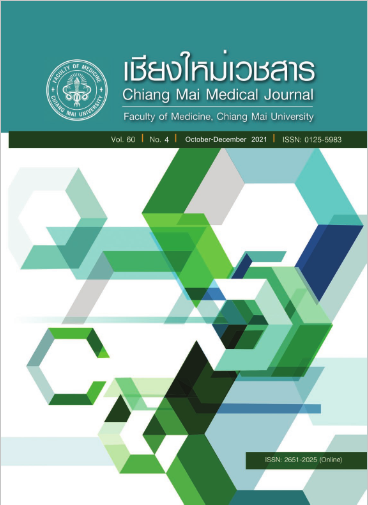The effectiveness of fever management in pediatric overtime Out-patient Clinic at Maharaj Nakorn Chiang Mai Hospital
Main Article Content
Abstract
Objectives To determine the effectiveness of fever management among febrile children in pediatric overtime outpatient clinic at Maharaj Nakorn Chiang Mai Hospital.
Methods The research was a descriptive retrospective study with 1,585 children who were 1 month to 6 years old with body temperature more than or equal 37.5 degree Celsius and visited in pediatric overtime outpatient clinic at Maharaj Nakorn Chiang Mai Hospital. The data was collected from hospital statistics and the medical records from 1 January 2017 to 31 December 2017. The data was analyzed by using the Statistic Package for the Social Science of Windows (SPSS).
Results The result illustrated that 1,585 sampling patients, 57.40% of them were at the age of 1-3, 33.30% were diagnosed with respiratory diseases, and 1.20% had a history of febrile seizure. From the data collection, the patients were cured by 3 methods: tepid sponge with paracetamol 65.20%, only paracetamol 19.10% and only tepid sponge 15.70%. Furthermore, the study showed that after the cure 99.9% of the patients did not develop febrile seizure. The average body temperatures after management was decreased statistically significant at the .01 level.
Conclusion The fever management among febrile children in pediatric overtime outpatient clinic at Maharaj Nakorn Chiang Mai Hospital could decrease the body temperature.
Article Details

This work is licensed under a Creative Commons Attribution-NonCommercial-NoDerivatives 4.0 International License.
References
2. สรชัย ศรีสุมะ. สรีรวิทยาของการควบคุมอุณหภูมิกาย Thermoregulatory Physiology.[ Power Point slides]. 2008 [ 9 สิงหาคม 2561]. เข้าถึงได้จาก http://www.ps.si.mahidol.ac.th/courseware/storeresources
3. บล็อคหาหมอดอทคอม.ไข้ อาการไข้ตัวร้อน (Fever) [อินเทอร์เน็ต]. 2558 [09 สิงหาคม 2561]. เข้าถึงได้จาก: http://haamor.com
4. Gildea JH. When fever become an enemy. Pediatric Nursing 1992; 48:143 –47.
5. Harkreader H, Hogan MA. Managing body temperature. Fundamentals of Nursing Caring and Clinical Judgment.2007; 2: 107.
6. ศรีศุภลักษณ์ สิงคาลวณิช, ชัยสิทธิ์ แสงทวีสิน, สมจิต ศรีอุดมขจร และสมใจ กาญจนาพงศ์กุล ปัญหาโรคเด็กที่พบบ่อย.พิมพ์ครั้งที่ 1. กรุงเทพฯ: สถาบันสุขภาพเด็กแห่งชาติมหาราชินี; 2549.
7. Muscari ME. Pediatric Nursing. 3 ed. Lippincott: Williams & Wikins; 2001.
8. สรวิศ วีรวรรณ. ภาวะชักจากไข้ คืออะไร[อินเทอร์เน็ต].กรุงเทพฯ:คณะแพทยศาสตร์ศิริราชพยาบาล มหาวิทยาลัยมหิดล; 2561 [เข้าถึงเมื่อ 27 เมษายน 2561. เข้าถึงได้จาก www. si.mahidi.ac.th.
9. Watts R, Robertson J, Thomas G. Nursing Management of fever in children, Intervention Journal of Nursing practice 2003; 9 (1): 51-8.
10. จิราภรณ์ รุ่งเรือง. แนวปฏิบัติการจัดการภาวะไข้ในผู้ป่วยเด็ก [อินเทอร์เน็ต].เชียงใหม่ : การพยาบาลผู้ป่วยนอกและผู้ป่วยฉุกเฉิน โรงพยาบาลมหาราชนครเชียงใหม่ คณะแพทย์ศาสตร์ มหาวิทยาลัยเชียงใหม่; 2558 [04 กุมภาพันธ์ 2563]. เข้าถึงได้จาก www.med.cmu.ac.th
11. บล็อคโรงพยาบาลดีบุก.การดูแลไข้ในเด็ก โรงพยาบาลดีบุก [อินเทอร์เน็ต]. 2561 [16 สิงหาคม 2561]. เข้าถึงได้จาก: http//www.dibukhospital.com>fever-children
12. กาญจนา จันทวงศ์ และยุพิน เพียรมงคล. การลดไข้ในเด็ก. วารสารพยาบาลสวนดอก โรงพยาบาลมหาราชนคร เชียงใหม่ 2550;13,1: 49-55.
13. Thomas S, Vijaykumar C, Naik R, Moses PD, Antonisamy B. Comparative Effectiveness of Tepid Sponging and Antipyretic Drug Versus Only Antipyretic Drug in the Management of Fever Among Children, Indian Pediatrics 2009;46:133-36.
14. งานสุขศึกษาและประชาสัมพันธ์ โรงพยาบาลท่าตูม จังหวัดสุรินทร์.โรคไข้ชัก [อินเทอร์เน็ต].2557 [09 สิงหาคม 2561] เข้าถึงได้จาก: www.thatoomhsp.com


